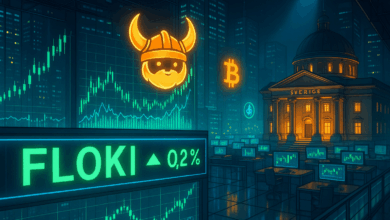Bitcoin Now Just One of Many Ways for Retail to Onboard to Crypto
When Bitcoin first emerged in 2009, it wasn’t just a novel idea—it was the entirety of the cryptocurrency universe. As the first digital currency built on blockchain technology, Bitcoin paved the way for a new financial paradigm, one that emphasized decentralization, limited supply, and transparency. For several years following its launch, Bitcoin commanded almost all investor attention. Retail investors, institutional actors, and developers alike were primarily focused on BTC. It was the sole onramp into crypto, the defining benchmark for performance, and the single point of entry for those seeking to explore this emerging asset class.
Yet, the crypto landscape today looks dramatically different. What once was a Bitcoin-dominated ecosystem has evolved into a multifaceted, diverse arena filled with alternative blockchain networks, assets, and use cases. Bitcoin still holds a place of respect and relevance, but it is no longer the only game in town. For those looking to maximize returns and engage more directly with the evolving world of decentralized finance (DeFi), non-fungible tokens (NFTs), and Web3 applications, it’s clear that the most exciting opportunities lie far beyond Bitcoin itself.
A Wealth of Onramps
In earlier years, joining the crypto market required converting fiat into Bitcoin through relatively limited channels. But technological advancements and greater institutional adoption have dramatically expanded the ways in which users can onboard. Today’s crypto newcomers aren’t limited to Bitcoin as their first purchase. In fact, many bypass it entirely.
Yield farming, staking, and liquidity provision offer opportunities to earn returns on tokens such as Ethereum (ETH), Polygon (MATIC), and Avalanche (AVAX). These activities are made accessible through decentralized exchanges (DEXs) like Uniswap, PancakeSwap, and SushiSwap. Automated Market Makers (AMMs) further facilitate seamless, permissionless trading of a broad array of crypto assets without requiring centralized custodians.
Consumer-oriented apps and web wallets, such as MetaMask and Trust Wallet, allow users to directly interact with decentralized applications (dApps), often without ever holding BTC. These platforms make it easier for participants to engage with DeFi protocols, swap tokens, mint NFTs, and interact in Web3 ecosystems backed by various blockchains.
Further enhancing accessibility, traditional fintech firms like PayPal, Robinhood, and Venmo have entered the crypto space. These platforms now allow users to purchase, hold, and transfer altcoins including Ethereum, Litecoin, Solana, and more—all against fiat currencies. Legacy players like Coinbase, Binance, and Kraken continue to evolve with expanded listings and new financial products, ensuring users can directly access a wide variety of assets without ever touching Bitcoin.
Bitcoin’s Shrinking Market Share
Bitcoin’s dominance as a percentage of the overall crypto market cap is a critical metric for understanding the industry’s evolution. In its prime, Bitcoin accounted for more than 90% of crypto’s total value. Today, that number has comfortably settled below 50%, despite recent price rallies. This shift illustrates the growing diversification within the asset class, as investors aim to capture alpha in faster-moving, higher-upside assets.
This trend mirrors the broader evolution of financial markets. Investing solely in Bitcoin in a mature crypto environment is akin to investing exclusively in large-cap U.S. equities and ignoring small-cap or emerging international stocks. While such an approach may yield steady returns, it misses out on the moonshot potential of up-and-coming assets and protocols that embody the cutting edge of blockchain innovation.
Bitcoin remains a foundational element of the crypto economy. It’s widely seen as a store of value, a digital hedge against inflation, and a macroeconomic safe haven. It serves a crucial role in the portfolios of institutions and risk-averse investors. But those seeking exponential gains, or wanting to engage deeply with the technological infrastructure reshaping finance and the internet, are increasingly turning to more nimble and versatile networks.
Fresh Capital, New Channels
Retail capital is increasingly entering the crypto market through avenues far removed from BTC. This new wave of investors often arrives with a different mindset—one characterized by a higher risk tolerance and a deeper interest in digital-native experiences. They’re not just buying tokens—they’re participating in ecosystems.
- Layer 2 Networks: Emerging Layer 2 solutions like Arbitrum (ARB), Optimism (OP), and Base are gaining traction by offering low-cost, high-speed alternatives to Ethereum’s sometimes-congested mainnet. These scaling solutions are thriving on the strength of their communities, developer support, and rapidly growing dApp ecosystems. Users interact with these networks to access DeFi applications, gaming platforms, and NFT marketplaces—all without needing to go through Bitcoin.
- Stablecoins and Financial Access: Stablecoins like USDT (Tether), USDC (USD Coin), and DAI are bridging traditional finance and crypto. Pegged to the U.S. dollar but fully digital, these assets allow users to store value in a stable medium while taking advantage of blockchain speed and global accessibility. In countries facing inflation or economic instability, stablecoins provide essential financial stability and cross-border payment capabilities—often serving as introductory tools for crypto newcomers.
- Multi-Use Blockchain Ecosystems: Popular Layer 1 protocols such as Solana (SOL), Cardano (ADA), and Avalanche (AVAX) have proven that the future of crypto lies in utility. These platforms support smart contracts, decentralized finance, and NFT issuance, often within highly active and engaged communities. Through fiat onramps like Coinbase and Binance, retail investors can access these protocols directly, taking part in interactive blockchain platforms that offer far more than just speculative price action.
The user who logs into a mobile app to purchase $100 of SOL isn’t simply making an alternative investment. They’re often interacting with an entire ecosystem, perhaps purchasing their first NFT or providing liquidity in a DeFi pool. This immersion into functional, application-oriented aspects of cryptocurrency is shaping a new kind of market participant—one who is more engaged and more interested in product functionality than Bitcoin’s narrative as digital gold.
Macro Trends and Institutional Demand
Institutional players have not abandoned Bitcoin, and their presence continues to shape macro narratives. From public companies adding BTC to their balance sheets to the rise of Bitcoin ETFs and futures markets, the asset has matured into a legitimate financial instrument in the eyes of regulators and fund managers alike.
Still, even within institutional circles, diversification is increasing. Fidelity, BlackRock, and other major firms are allocating to Ethereum and exploring tokenized assets and stablecoin-related infrastructure. New hedge funds and venture capital vehicles focus almost entirely on non-Bitcoin investments, betting on Web3, metaverse initiatives, and tokenized real-world assets (RWAs).
This widening appetite reinforces the broader point: Bitcoin is a chapter in the crypto story, but not the whole book. Investors are now looking at crypto through a broader lens—one that includes technological innovation, revenue-generating smart contract protocols, decentralized governance, and novel use cases that stretch far beyond store of value narratives.
Conclusion: Bitcoin is the Safe Bet, Not the Speculative Play
There is no denying that Bitcoin has earned its place as the most recognized and trusted cryptocurrency. With its finite supply, deep liquidity, and unparalleled security, BTC remains the digital equivalent of a blue-chip asset—a cornerstone for conservative crypto portfolios and a consistent performance benchmark.
However, recognizing Bitcoin’s stability also means acknowledging its limitations in terms of innovation and adaptability. In a rapidly evolving digital economy, growth often arises from exploration—not consolidation. Speculators, builders, and forward-looking investors are increasingly gravitating toward protocols that offer composability, faster transaction speeds, on-chain programmability, and expanded use cases within finance, identity, and digital ownership.
In 2024 and beyond, treating Bitcoin as your only access point to crypto doesn’t reflect caution—it reflects a narrow view. The real action is taking place across a wide spectrum of blockchains, each with their own communities, governance models, and innovation trajectories. Whether you’re exploring decentralized lending, interoperable networks, or blockchain-native games, the future of cryptocurrency is multi-chain, multi-functional, and moving fast.
If Bitcoin got you in the door, great—but don’t stop there. The broader crypto ecosystem is packed with possibilities, and it’s only just beginning to show its full potential.
Source link





